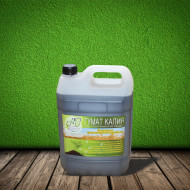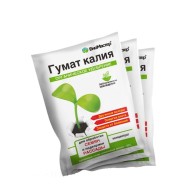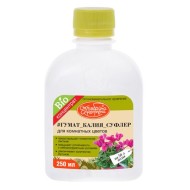Potassium humate for high yields: instructions for use, composition and mechanism of action
Content
Description of potassium humate
Plant residues, manure, peat, silt and brown coal are used as raw materials for the production of humates. The formation of humus occurs as a result of the natural decay of organic matter. Depending on the technique used and the source material, humuses are ballast and ballastless. Ballast fertilizers stimulate growth and strengthen cultivated plants, ballastless fertilizers saturate the soil with micronutrients. Therefore, humates are often called broad-spectrum biological activators.
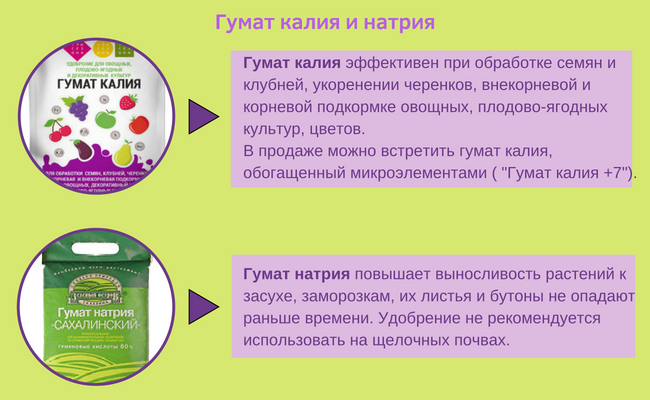
Humic fertilizers are sodium and potassium
Video "What is potassium humate?"
In this video, experts talk about the features of the application, useful properties and benefits of a biological plant growth activator.
Composition and mechanism of action
Humic fertilizers are classified into two main types - sodium and potassium. Today we will focus on potash humate. So, potassium humate contains about 80% of humic acids. Also, the biological activator contains growth stimulants, amino acids, antibiotics, enzymes, fats and peptides.
The drug is used to fertilize the soil for sowing seeds and planting seedlings, as well as for processing cuttings and adult plants. The action of potassium humate is aimed at neutralizing or partially reducing the acidity level of the substrate. Vegetable, fruit and ornamental crops grown on such soil are highly viable.

Characteristic signs of excess / deficiency of potassium in plants
Beneficial features
According to experienced gardeners and gardeners, potash humate has a wide range of useful properties:
- Lowering / neutralizing soil acidity.
- Enhanced action of organic fertilizers.
- Restoration of useful properties and nutritional functions of the soil mixture.
- Enrichment of the soil with microelements necessary for the growth and development of plants.
- Neutralization of the toxic effect of fungicidal and insecticidal preparations during pest and disease control.
- Increase of plant resistance to temperature extremes and various weather events.
- Effective reduction of the amount of fertilizing with nitrogen-containing agents.
The drug is classified as environmentally friendly and safe for people, animals and plants bioactivators. Fertilizer based on natural organic components is often called peat fertilization.
Benefits of Application
The main advantages of potassium humate include:
- acceleration of seed germination and the formation of fruit ovaries;
- high rates of fruiting;
- healthy and rich harvest;
- increasing the vitality and strengthening the roots of cultivated crops;
- increasing plant resistance to attacks of harmful insects and pathogens of various infections;
- improving soil fertility.
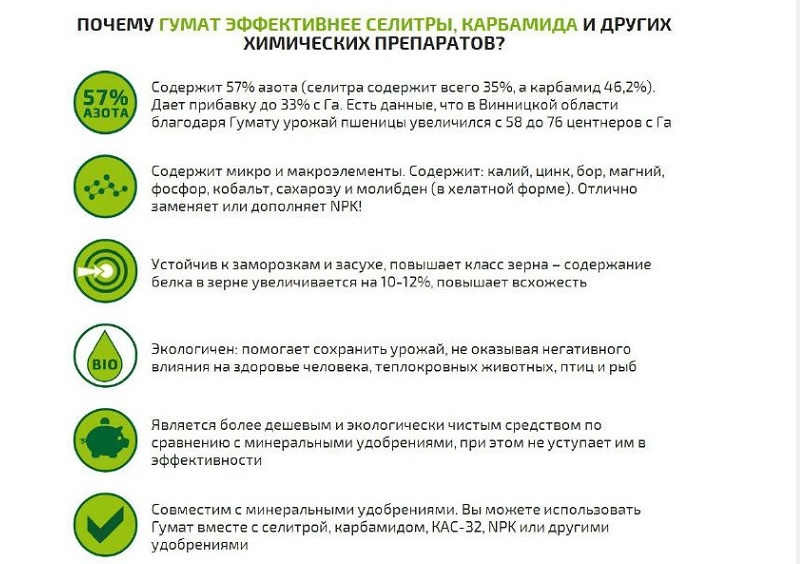
Indicators of the effectiveness of potassium humate in comparison with other means
Varieties of the drug
For ease of use, the drug is produced in different types and forms.
Liquid form of fertilizer
The dark brown concentrate contains nutrients present in peat.
Since the liquid is characterized by a high concentration of humic acids, it is diluted with cool water before use. So, for prophylactic spraying of vegetation in the garden and in the garden or soaking the seed, only 0.01% of the concentrate of the total amount of fertilizer is needed. To improve the chemical and physical characteristics of the soil mixture, 0.1–0.2% of undiluted bioactivator is used.
The liquid form of fertilizer can be used simultaneously with organic fertilizing and nitrogen-containing products.
Powdered form
Powdered biostimulant strengthens the immunity of grown crops. The drug helps to increase the endurance of plants, and also has a beneficial effect on the speed of formation of ovaries and fruits. Powdered potassium humate has a mild effect on weakened and disease-damaged crops. Increases their vitality and strengthens the roots.
According to experts, dry powder accelerates the formation of microflora in the soil. The rapid formation of humus in the soil increases the productivity of the cultivated plants by 50%.
Few people know that according to its properties and qualities, 1 kg of powdered potassium humate replaces 1 ton of humus.
Potassium humate "Prompter"
Complex fertilizer "Prompter" is produced from bottom sediments of fresh water bodies. The nutrient is added every 15 days. In case of heavy precipitation, it is better to postpone top dressing for several days. The solution prepared according to the instructions cannot be stored, since it loses its quality over time.
The use of the universal complex of nutrients begins in March. The duration of intensive dressing lasts until September. During the period when plants are at rest and rest, the drug "Sulfate" is used no more than 1 time in 30–35 days.
Instructions for the use of potassium humate
For soil cultivation and spraying of plants, a biological growth activator diluted with water is used. For spraying the crowns of fruit crops, 3 g of powder is stirred in 10 liters of water. To soak the seeds, ⅓ tsp. the drug is added to 1 liter of water. For watering and root feeding of grown crops, take 10 liters of water and 1 tbsp. l. fertilizers.
For vegetables
A solution of potassium humate is used to increase the yield of vegetable crops. Vegetables grown on the beds are fed 2–6 times during the growing season. According to gardeners' reviews, tomatoes, cucumbers, zucchini, beets, cabbage and carrots are fertilized with a bioadditive 4 times per season. Potatoes are soaked before planting and sprayed at least 4 times.
To prepare a nutrient of the desired concentration, you will need 10 liters of water and 100 ml of a biological growth activator.

Potassium humate solution improves yield indicators
For greenery
Greens grown in beds and in the garden need nutrients. The lack of humus negatively affects the vegetation: the seeds give a low percentage of germination, the greens turn yellow, dry and wither, the growth of green mass is almost completely absent. Potash dressings are used to help plants. A mixture of water (5 l) and potassium humate (50 ml) increases the rate of germination of the seed and intensive growth of green mass. At the same time, the characteristic natural taste of greens is preserved.
The frequency of fertilizing depends on the weather conditions, the degree of soil depletion and the varietal characteristics of the grown greens. On average, vegetation is fed 2 to 6 times per season.
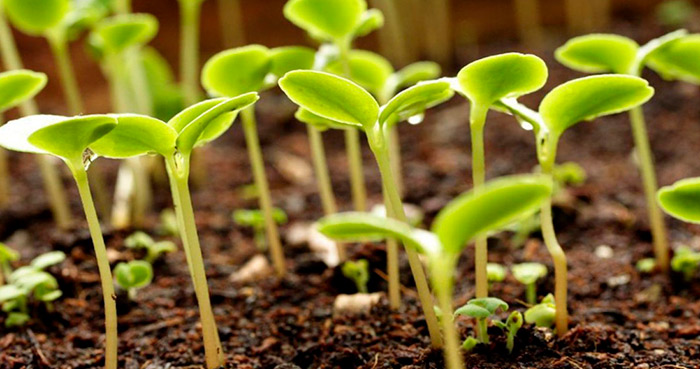
Nutrient-rich soil produces good seed germination
For fruit and berry
Fruit and berry plants require special attention of gardeners. Trees and bushes are cultivated in early spring before the budding phase and at the stage of fruit formation. For watering and spraying, use a solution of 10 liters of water and 100 ml of the drug. Consumption of ready-made solution per 1 m² varies from 3 to 10 liters.
For 100 m² of orchard, you need 3 liters of potassium humate solution. We are talking about spraying the crowns of cultivated fruit and berry plants.
For garden flowers
The first feeding of flowers grown on the territory of the personal plot is carried out in the spring, when annual crops begin to actively germinate, and perennials enter the growing season. Subsequent dressings are performed every 14–20 days, after mixing 1 liter of water and 100 ml of liquid fertilizer.
For indoor plants
Do not forget about feeding indoor plants with potassium humate. The lack of humus in the substrate can cause wilting or rotting of the decorative flower. To prevent the death of the plant, nutrients are introduced into the soil.
Potassium humate promotes active growth, abundant and rich flowering of indoor flowers. From early March to September (inclusive), flowers are fed every 15 days. The frequency of such dressings in winter (from October to February) is reduced to 1 time in 1.5 months.
For watering and spraying the aboveground part of indoor flowers, 75 ml of biological growth activator is diluted with 1 liter of water. A miraculous remedy, as a broad-spectrum bioactivator is often called, is used for planting and transplanting indoor flowers. Gently remove the plant from the flowerpot, carefully remove the clods of soil and treat the root with a beneficial substance. After planting / transplanting, the substrate in the flowerpot can be moistened with a nutrient solution of low concentration.
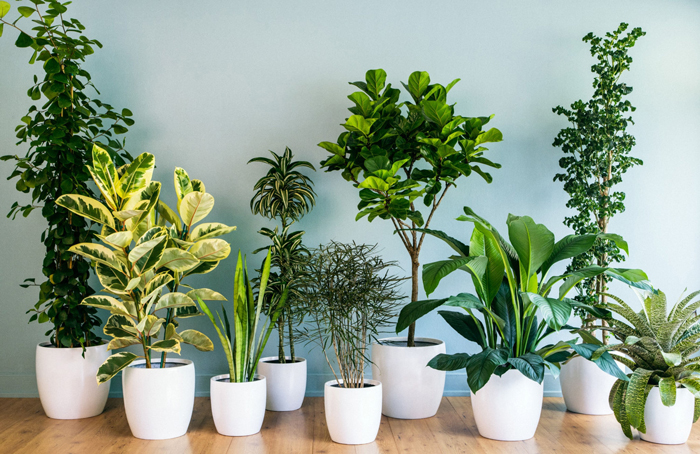
Compatibility with other fertilizers
Potassium humate cannot be used simultaneously with potassium nitrate and phosphorus-containing agents. This tandem forms insoluble compounds in the soil. When fertilizing the soil, a 5-day interval should be made. First, potassium is added, then phosphorus-containing substances.
Every gardener and gardener knows that the fruiting of crops and crops depend on the presence of nutrients and useful trace elements in the soil. To restore the balance of nutrients in the soil, organic and mineral fertilizers are used. However, natural supplements are considered to be more effective and beneficial. It is these substances that include potassium humate.

